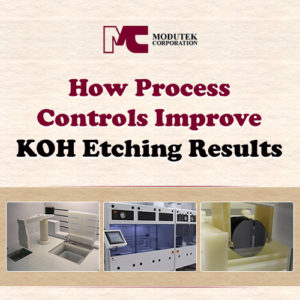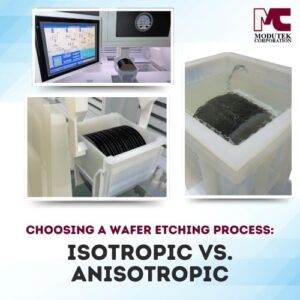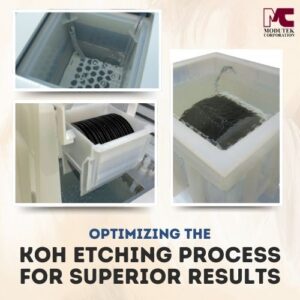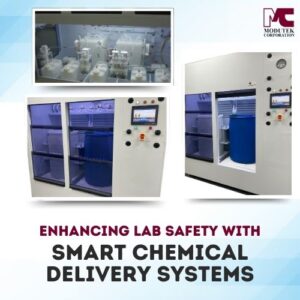 While potassium hydroxide (KOH) etching is a versatile process for creating silicon microstructures, precise and responsive controls are required to get superior results. The KOH wet bench process is popular because KOH etches quickly and it is less hazardous than some other processes. Combined with accurate chemical delivery and reliable process controls, KOH etching can deliver exact etching dimensions and reproducible results for batch processing.
While potassium hydroxide (KOH) etching is a versatile process for creating silicon microstructures, precise and responsive controls are required to get superior results. The KOH wet bench process is popular because KOH etches quickly and it is less hazardous than some other processes. Combined with accurate chemical delivery and reliable process controls, KOH etching can deliver exact etching dimensions and reproducible results for batch processing.
KOH Etching Can Create Complex Shapes
The KOH process is used widely because, in addition to etching quickly, it can be set up to etch at different speeds in different directions. For example, technicians may want to etch downward, into the silicon wafer, more quickly than etching in a horizontal direction. They may want to create a rectangular shape, where the long side has a different etch rate than the short side.
The etching direction is influenced by the crystal lattice orientation of the silicon wafer and possible doping of the wafer with boron. The etching speed depends on the KOH mixture concentration and temperature. To obtain improved KOH etching results, the etching process has to be set up to include all these factors and produce the desired result every time the process runs.
When the microstructures to be etched into the wafer require different etching speeds, the process uses the fact that the crystal lattice can be denser in one direction than another. Because there are more atoms to etch away in the denser direction, etching progresses more slowly. Boron doping is a way to stop etching in a particular direction. KOH will not etch areas with boron impurities, so etching stops at the doped silicon.
Once the wafer with the correct crystal orientation and doping is ready for etching, a basic etch speed can be determined with the KOH concentration. The etch speed is controlled by the KOH mixture temperature but the concentration has to be high enough for the desired etch speed.
Typical KOH concentrations can vary from 10 percent to 50 percent with 30 percent KOH by weight representing a common value. The mixture is heated to between 60 and 80 degrees centigrade and held steady at the temperature that gives the desired etch speed. With right wafer crystal orientation, doping in the right places and the correct etch speed, the microstructures will be completed in a given time.
Teflon Tanks with Precise Controls Produce Improved Output
The Teflon tanks designed and manufactured by Modutek feature the precise temperature controls and accurate support equipment that an effective KOH process requires. To etch the silicon wafer with a high degree of accuracy, operators have to make sure the concentration of KOH is at exactly the right value and have to be able to control the temperature within narrow limits.
Modutek’s wet bench equipment can deliver the KOH mixture to the Teflon tanks at the right concentration. The tank temperature controls can produce a heating rate of 2 to 3 degrees centigrade per minute, leading to rapid correction of temperature deviations. The controller accuracy is plus/minus 0.5 degrees centigrade, precise enough for excellent etching speed control.
The precise controls mean that the etch rate remains exactly at the desired level. The dimensions of the silicon microstructures are etched exactly as planned and the KOH process delivers high-quality output. Equally important is that the next time a batch is run with identical requirements and settings, the output is reproducible and the silicon microstructures are the same.
Modutek offers a complete line of wet bench processing equipment and can adapt the KOH etching tanks as well as other processing stations to meet the needs of its customers. All equipment is designed and built-in house, allowing for extensive customization and unparalleled customer support and service.




